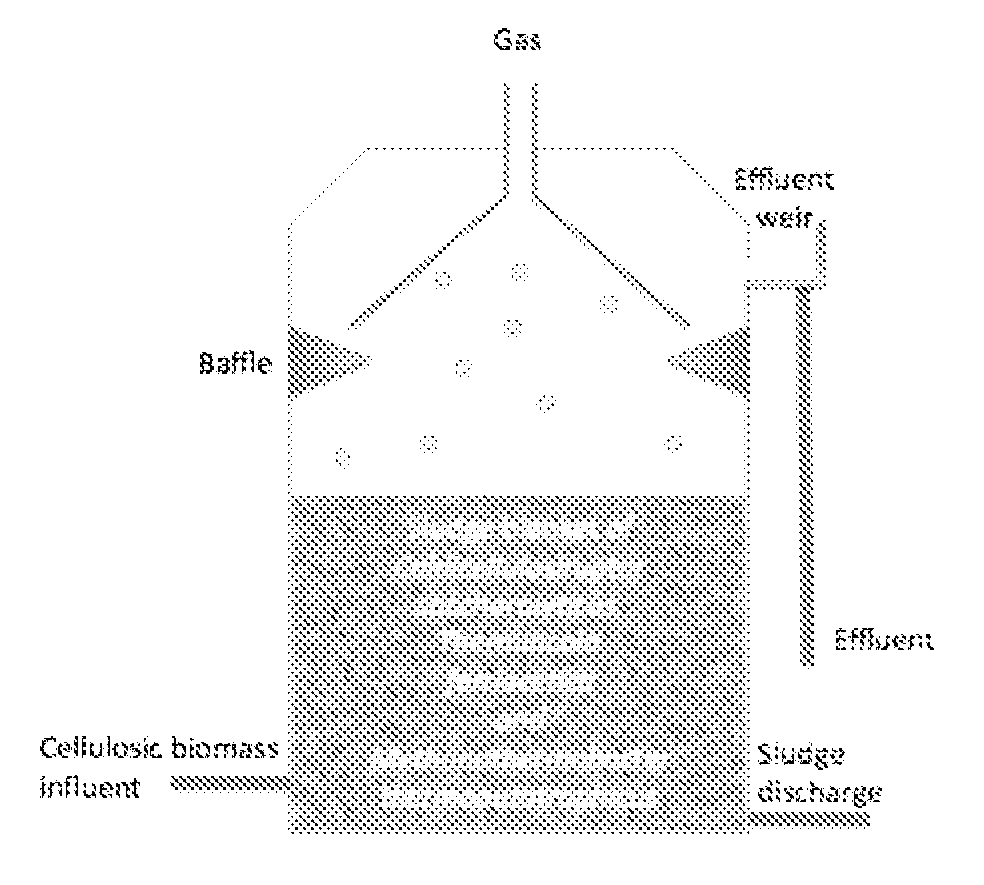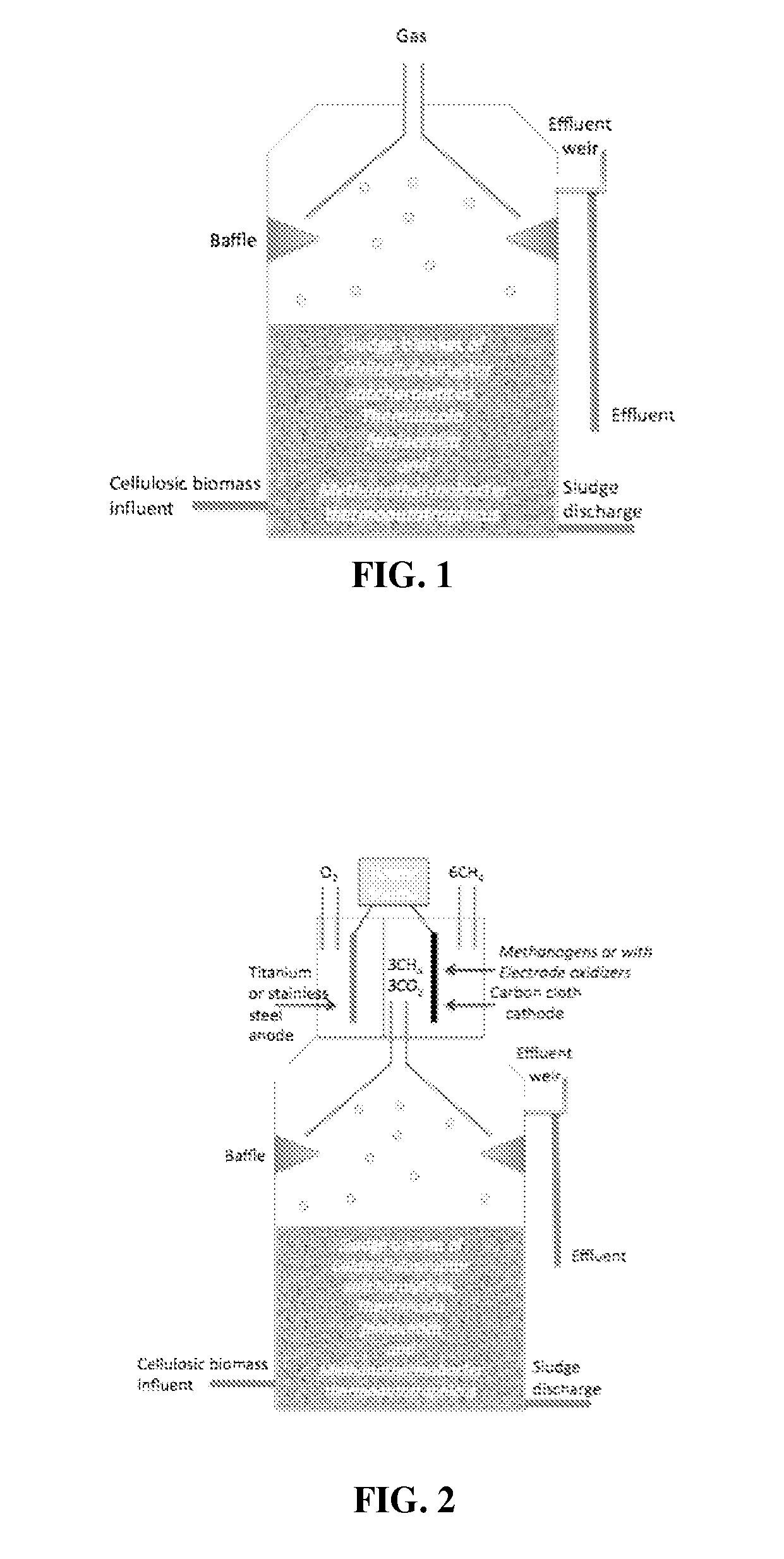Thermophilic methanogenic consortium for conversion of cellulosic biomass to bioenergy
a methanogenic consortium and cellulosic biomass technology, applied in the field of methanogenic microbial consortium for biomass conversion to methane, can solve the problems of finite energy source, diminishing supply, and energy sources such as fossil fuels, coal, oil and natural gas,
- Summary
- Abstract
- Description
- Claims
- Application Information
AI Technical Summary
Benefits of technology
Problems solved by technology
Method used
Image
Examples
example 1
Co-Cultures
[0111]Co-Culture of C. saccharolyticus and M. thermoautotrophicus
[0112]This example provides an examination of the physiological interaction between the cellulose hydrolyzing C. saccharolyticus (DSM 8903) and a hydrogenotrophic methanogen, Methanobacter thermoautotrophicus strain AH (DSM 1053). This will determine the effect of interspecies hydrogen and acetate transfer on the cellulose hydrolyzing extreme thermophile. C. saccharolyticus will be maintained in anaerobic DSMZ 640 medium with 50 mM glucose or with 10 g / L crystalline cellulose (Avicel) at 70° C. M. thermoautotrophicus will be maintained in anaerobic DSMZ 119 medium under 2 atm 80:20 (vol:vol) headspace of H2:CO2 at 65° C. All cultures will be maintained in 10 ml of media in anaerobe tubes or in 50 ml of media in 150 ml serum bottles, each sealed with black butyl stoppers. Cellulose will be measured directly by dry weight after washing of the spent media and indirectly by spectrophotometric measurement of glu...
example 2
Enhancement of Cellulose Hydrolysis by C. saccharolyticus Grown-in Co-Culture with M. thermoautotrophicus
[0123]Co-culturing C. saccharolyticus with M. thermoautotrophicus significantly improved the rate and yield of cellulose hydrolysis in comparison with a monoculture of C. saccharolyticus. When grown on cellulose in semibatch reactor, the production rate and yield of hydrogen, which was completely converted to methane in the coculture, were 2× greater than that from a monoculture of C. saccharolyticus (FIG. 9). The yield of hydrogen (22.7 mmol H2 / g cellulose) in the coculture reached 89% of the theoretical maximum (24.7 mmol H2 / g cellulose calculated using glucose units and Thauer's limit), while that of the monoculture was 48% of the theoretical maximum (12.0 mmol H2 / g cellulose).
[0124]Moreover, co-culturing C. saccharolyticus with M. thermoautotrophicus affected the distribution of fermentation products besides H2 by producing significantly less lactate and more acetate than th...
example 3
Tri-Culture of C. saccharolyticus, M. thermoautotrophicus and T. lettingae
[0125]The methodology and conditions described in Example 1 are applied here but with the addition of the acetogenic syntroph T. lettingae (DSM 14835). T. lettingae will be maintained in anaerobic DSMZ 664 medium at 65° C. with glucose or acetate as carbon sources. In the latter case, thiosulfate will be added as an electron acceptor. In addition, the yeast extract of the medium will be reduced to 0.5 g / L (proven sufficient by Balk et al. (Balk, M., et al. Int. J. Syst. Evol. Microbiol. (2002)52:1361-1368.). T. lettingae has been shown to grow in co-culture with M. thermoautotrophicus strain ΔH with acetate as the sole carbon source (Balk, M., et al.). Each microorganism is capable of growing in all DSMZ media described and has a similar temperature, pH and salinity optimum. Cellulose consumption, product formation, methane yields and rates, and specific growth rates will be assayed as described in Example 1....
PUM
 Login to View More
Login to View More Abstract
Description
Claims
Application Information
 Login to View More
Login to View More - R&D
- Intellectual Property
- Life Sciences
- Materials
- Tech Scout
- Unparalleled Data Quality
- Higher Quality Content
- 60% Fewer Hallucinations
Browse by: Latest US Patents, China's latest patents, Technical Efficacy Thesaurus, Application Domain, Technology Topic, Popular Technical Reports.
© 2025 PatSnap. All rights reserved.Legal|Privacy policy|Modern Slavery Act Transparency Statement|Sitemap|About US| Contact US: help@patsnap.com



